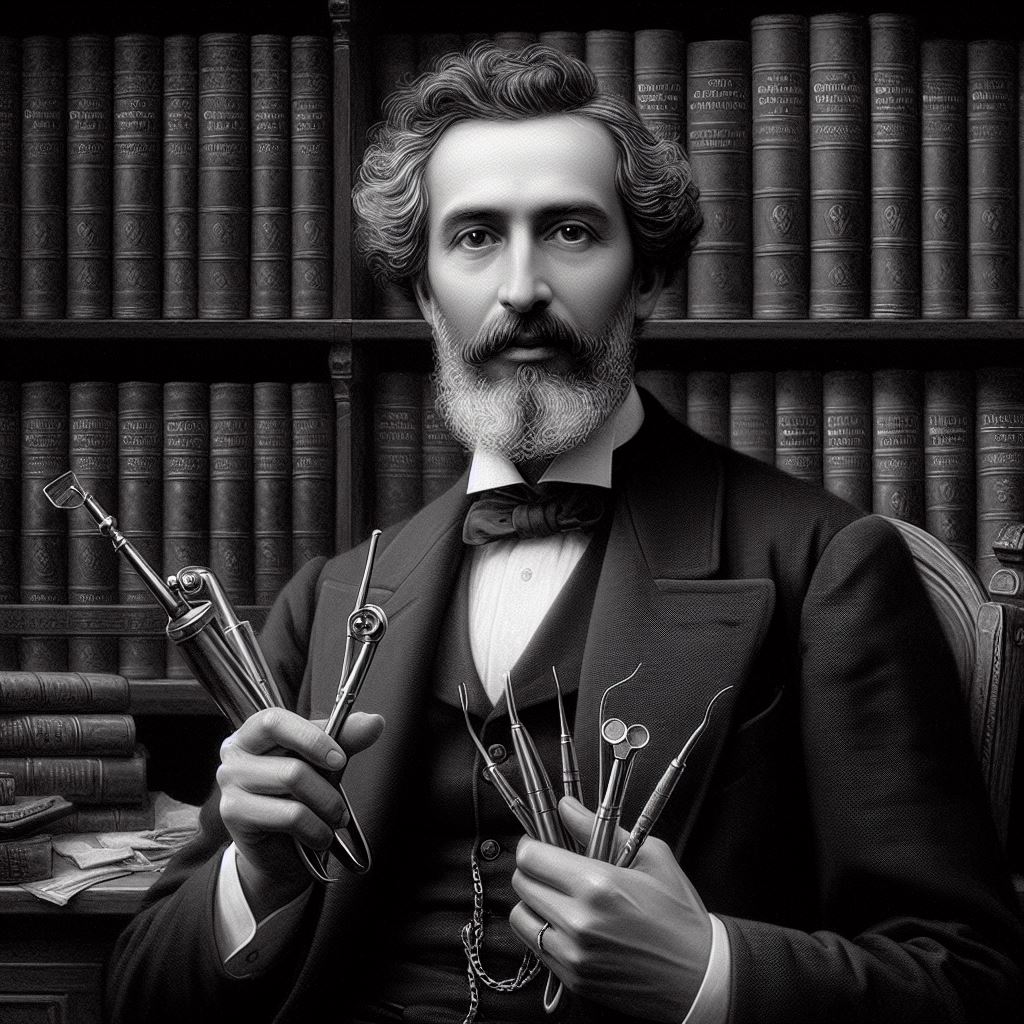Last Updated on 3 weeks by DR. ALBIN SIPES
The Etruscans are credited with inventing false teeth. They were an ancient civilization in Italy known for their dental advancements.
Using materials like human and animal teeth, gold, and ivory, they created early forms of dentures. The Etruscans’ innovation laid the foundation for modern dentistry, making significant contributions to the evolution of false teeth. Their techniques and materials have influenced the development of dental prosthetics over the centuries.
Today, false teeth are a common solution for individuals with missing or damaged teeth, helping to restore functionality and confidence. Understanding the history of false teeth sheds light on the progression of dental care and the creativity of ancient civilizations in addressing oral health challenges.
The Origins Of False Teeth
False teeth, also known as dental prosthetics or dentures, have a long history that dates back to ancient civilizations. The quest for solutions to dental problems has led to intriguing discoveries that shed light on the origins and evolution of false teeth.
The Quest For Dental Solutions Across Ancient Civilizations
Ancient civilizations across the world grappled with dental issues, leading to the exploration of various methods to replace missing teeth. From early attempts using materials such as animal teeth and wood to the advancements in modern dentistry, the journey of false teeth is a testament to human innovation and resilience in the face of oral health challenges.
Tracing The Earliest Evidence Of Dental Prosthetics
The earliest evidence of dental prosthetics can be traced back to ancient civilizations such as the Egyptians, Etruscans, and Romans. These early cultures utilized materials like ivory, bone, and gold to create dental prosthetics, demonstrating a remarkable understanding of dental technology for their time. The evolution of false teeth reflects the ingenuity and resourcefulness of these ancient societies, laying the groundwork for the development of modern dental prosthetics.
Which Country Pioneered False Teeth Innovation
Often dubbed as the birthplace of modern dentistry, France is attributed to pioneering the innovation of false teeth. With a rich history steeped in prosthodontics, France established itself as an early adopter in the development of prosthetic teeth. The evolution of false teeth and prosthodontics can be traced back to ancient civilizations, with the French playing a significant role in shaping the trajectory of this dental discipline. Delve deeper into the history of false teeth and discover the intriguing journey of its inception and evolution.
Early Adopters In The History Of Prosthodontics
Long before the advent of modern dental technology, civilizations across the globe experimented with various forms of prosthodontics. Among the early adopters in the history of prosthetic teeth were the Etruscans, who used gold to fashion artificial teeth as early as 700 BCE. The utilization of materials such as human and animal teeth, ivory, and metal in the creation of dental prostheses is evident in archaeological findings from ancient cultures. However, it was in France where significant advancements in prosthodontics began to take shape, laying the foundation for modern dentistry.
Culminating Clues And Archaeological Findings
Archaeological discoveries and historical accounts provide compelling evidence of France’s pivotal role in the development of false teeth. From the utilization of innovative materials to the refinement of denture designs, the contributions of French practitioners and artisans have left an indelible mark on the evolution of prosthodontics. The intricate detailing and craftsmanship of early French prosthetic devices attest to the nation’s commitment to advancing dental restoration techniques, shaping the trajectory of false teeth innovation.
Crafting The First Set Of Dentures
The history of false teeth dates back to ancient civilizations, where people utilized various materials and methods to create rudimentary dental prosthetics. However, it was in the 18th century when significant advancements in crafting dentures were made, leading to the invention of the first set of dentures as we know them today.
Materials And Methods In Ancient Dentistry
Ancient cultures such as the Egyptians, Etruscans, and Romans used materials like ivory, animal teeth, and human teeth to fashion dental prosthetics. Methods included carving and binding these materials together with gold wire or other metals. The Etruscans, in particular, were known for crafting sophisticated dental bridges using gold bands and animal teeth, demonstrating a remarkable level of skill in early dentistry.
Notable Advancements And Contributions By Country
Throughout history, several countries have made significant contributions to the development of dentures. In the 18th century, France emerged as a leader in denture craftsmanship, with notable individuals such as Alexis Duchâteau pioneering the use of porcelain to create durable and aesthetically pleasing dentures. The United States also played a crucial role, as American inventors, including John Greenwood and Josiah Flagg, improved the fit and comfort of dentures by experimenting with innovative materials and designs.
Etruscans And Egyptians: False Teeth Forerunners
The history of false teeth dates back to ancient civilizations, with the Etruscans and Egyptians standing out as forerunners in this remarkable innovation. Their early developments in dental prosthetics laid the foundation for the evolution of false teeth, shaping the way we perceive oral health and aesthetics today.
Gold Bands And Human To Animal Teeth Substitution
One of the most intriguing aspects of the Etruscan and Egyptian false teeth innovations was the use of gold bands to secure artificial teeth. These ancient civilizations displayed an advanced understanding of dental prosthetics by using gold to create functional and aesthetically pleasing false teeth.
Additionally, the utilization of human-to-animal teeth substitution was notable in their dental practices. This early form of dental restoration highlighted their resourcefulness and ingenuity in addressing dental issues.
The Impact On Social Status And Health
The introduction of false teeth had a profound impact on both social status and health in ancient societies. This innovative dental solution enhanced social status, allowing individuals to maintain a dignified appearance despite tooth loss. Moreover, it significantly improved oral health, enabling individuals to chew food effectively and maintain proper nutrition.
European Influence In Oral Prosthetics
The Progression Of Dentistry Through The Renaissance
In the history of dentistry, the Renaissance marked a significant turning point in the development of oral prosthetics. It was during this period that advancements in science, art, and technology converged, leading to the evolution of dental treatments and prosthetic devices.
France’s Pivotal Role In Advancing Dental Technology
Among the European countries, France played a pivotal role in advancing dental technology and contributing to the development of oral prosthetics. French dentists and artisans, influenced by the burgeoning Renaissance culture, began to explore innovative techniques and materials for creating false teeth and other dental prostheses.
Pierre Fauchard’s Contributions: The ‘Father of Modern Dentistry’

The story of false teeth and their evolution is a fascinating journey that owes much of its progress to the groundbreaking work of the French innovator Pierre Fauchard. Regarded as the ‘Father of Modern Dentistry’, Fauchard’s pioneering contributions revolutionized the field of dental care and prosthetics, laying the foundation for the development of false teeth as we know them today.
Advancements That Paved The Way For Modern False Teeth
French innovations in dentistry brought about significant advancements that paved the way for the creation of modern false teeth. These breakthroughs not only improved the functionality and comfort of dental prosthetics but also enhanced their durability and aesthetic appeal, transforming the experience of individuals seeking restorative dental solutions.
Conclusion
The history of false teeth is an intriguing tale that spans centuries and continents. While various cultures have contributed to the development of dentures, the credit for inventing false teeth is primarily attributed to the Etruscans and the Chinese. Exploring the origins of dentures reveals the fascinating evolution of dental practices across different civilizations.






